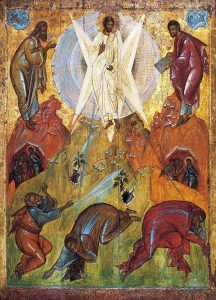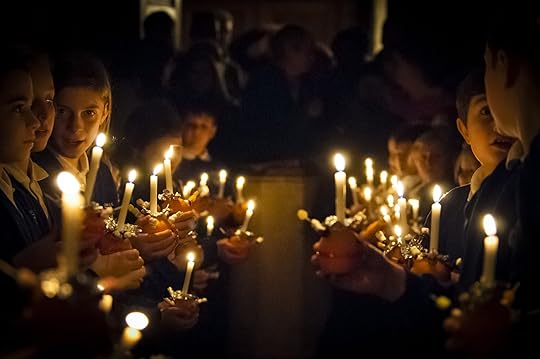Gary Neal Hansen's Blog, page 21
March 9, 2020
The Lord’s Supper and the Coronavirus — Wisdom from St. Thomas Aquinas

 I was supposed to preach Sunday. I was getting over a cold. Love of neighbor meant I needed to tell the pastor who invited me in case he wanted to cancel. He still wanted me to come.
I was supposed to preach Sunday. I was getting over a cold. Love of neighbor meant I needed to tell the pastor who invited me in case he wanted to cancel. He still wanted me to come.
Still, I told the congregation I wouldn’t be shaking hands. They didn’t want to catch what I’d had — though really, it was just a cold.
I bumped some elbows. We smiled, and we laughed. The laughter was a little anxious. This is the era of the “Novel Coronavirus,” a.k.a. “COVID-19.”
In the church my family usually attends, “passing the peace” is a very big deal — usually. Now it’s elbow bumps and waves, and that anxious laughter.
Not touching is culturally awkward. We shake hands without thinking, much of the time. It’s hard to remember, in the season of the Coronavirus, that keeping social distance is a matter of public health.
That is, we don’t shake hands, not out of fear of being infected, but out of love for our neighbor. We are doing our part to try to protect everybody.
The Lord’s Supper and the Coronavirus
But it’s really a much bigger issue when it comes to Communion — you may call it the Lord’s Supper or the Holy Eucharist. This shared bread, and shared wine (or, alas, in my Presbyterian circles, grape juice) is something Jesus gave us, and commanded us to celebrate.
What do we do about The Lord’s Supper and the Coronavirus?
Most of Christianity has the Eucharist every Sunday. What do we do when sharing food, and distributing it by hand, seems to be a public health risk?
My mother attends an Episcopal church in the Pacific Northwest. Episcopalians usually have the consecrated wine in a “common cup.” That is, the priest prays and says the sacred words of the liturgy over one cup of wine, and then, person by person, all take a sip.
I suspect at a directive of their bishop, yesterday they didn’t have the common cup.
As usual, they each received a wafer the consecrated bread, given with the holy words, “The Body of our Lord Jesus Christ, keep you in everlasting life,” or “The Body of Christ, the Bread of Heaven.”
And that was it. No chalice followed. No more holy words, “The Blood of Christ, the cup of salvation.”
Is Receiving Just the Bread Only Half a Sacrament?
I suspect that some Christians in the time of the coronavirus find themselves wondering if they only got half of the sacrament. If “Eucharist” means “Thanksgiving,” does this mean we’re only half-thankful?
Back in the Reformation, we Protestants made a very big deal of the need to receive both the consecrated bread and the consecrated wine. We objected to the medieval Roman Catholic practice of giving the bread to all, but allowing only the clergy to drink from the cup.
And we had a point, as to general practice. It was, as Luther pointed out, the cup, and not the bread, about which Christ was particularly pointed, saying
Drink this, all of you.
But despite Protestant polemics, there was some very helpful theological reasoning on this point well before Luther and Calvin.
Thomas Aquinas, O.P.
Enter St. Thomas Aquinas (1225-1274), the greatest and most influential of the medieval scholastic theologians. A lot of Protestants are just informed enough to dismiss St. Thomas. The Reformers loved to deride the “schoolmen” and their tightly reasoned logical theological systems.
They especially tended to dismiss the scholastics because they created theological arguments for things Protestants didn’t think could be supported by our beloved Bible.
There is, however, a vast amount to learn from Thomas Aquinas. He was smarter than me, that’s for sure. I’d wager he was smarter than you too. And he knew his Bible. And he knew the teachings of the greatest Christian thinkers who came in the 1200 years before him.
Thomas may have come to a number of views about the Eucharist that my Protestant colleagues are never going to buy. Still, I would argue that he is worth listening to on many, many points — including on the Lord’s Supper in the time of the Coronavirus.
(If my former students read this, now they’ll know why I made them read St Thomas’ Summa Theologica, Third Part, Questions 75, 76, 79, and 80.)
“Concomitance”
You see, Thomas lived in those middle ages when Christians as a general practice were given only the consecrated bread. He too had to deal with the question of whether people were given an incomplete sacrament.
For Thomas, and for Catholicism, it was a question of the real presence of Christ. Once consecrated, the bread and wine were understood to truly be the body and blood of Christ — no matter how much they still looked and tasted like bread and wine.
So Thomas asked, essentially, “What are you getting if you just get one of the elements?”
Thomas’ answer used a fancy theological word: “concomitance.” It’s a word that refers to one thing co-occuring with something else, two things existing along with each other.
The point: If you’ve got Jesus in the sacrament, you’ve got both his body and his blood — together.
If the wafer or loaf which started the service as mere bread now brings us the true presence of Christ, then it brings the whole Jesus. That’s both his body and his blood together. That’s “concomitance.”
(If you are keen to read Thomas on the topic, you can find the whole shebang at the amazing Christian Classics Etherial Library. This link will take you to a relevant section. However, as my students will confess, reading Thomas takes some practice. Teaching you how would be another blog post.)
I once had a conversation with a child who was hesitant to take communion, knowing that children aren’t supposed to drink wine. Teaching about concomitance was very useful. If the child received the bread, and let the cup pass by, then the child would still receive all that was promised.
Plus, the child would know a cool word that nobody else in grade school had heard before.
Good News
I think Thomas was right — and that what he said about the whole Christ being present in even one element of the sacrament is good news for us in the time of the Coronavirus.
Really, he was right no matter your view of the Eucharist:
whether you believe the bread and wine become the body and blood,
or whether you believe Christ is present in, with, and under the bread and wine,
or whether you believe Christ is spiritually present (and therefore really present),
or whether you believe that you are looking up to heaven where Christ as ascended bodily, while you feed on him in your heart by faith
When you receive Christ at the Eucharist, even if you receive only the sacramental bread, you receive the whole of Christ.
More to Come?
And if your city goes into lockdown and you can’t attend worship at all?
Thomas Aquinas has good news for you in that situation too.
He taught that we can receive the benefit of the Lord’s Supper by desiring it, even if we can’t actually attend and receive the sacrament bodily.
But that’s for another time.
++++++++++++
If you found this post helpful, please share it on social media. It’s easy: Just click on one of the sharing buttons below!
The post The Lord’s Supper and the Coronavirus — Wisdom from St. Thomas Aquinas appeared first on Gary Neal Hansen.
March 6, 2020
A Children’s Sermon on John 3:1-17

 Windblown trees, Humphrey Head cc by Dave Dunford-SA3.0
Windblown trees, Humphrey Head cc by Dave Dunford-SA3.0Jesus’ conversation with Nicodemus is fascinating, but what is the best way to introduce it in a children’s sermon?
My first inclination with a Gospel text is to tell the story. But this scene has very little narrative action: Nicodemus and Jesus just sit there and talk.
A conversation can have its own flow and drama. But this conversation is actually kind of confusing, with the two men seeming to miss each other’s meaning.
I think the too-easy route is to talk about John 3:16. In our culture that verse has so much gravity that we tend to think it is the biggest and best thing going on here. In my observation, we tend to assume a whole lot of theological concepts when we bring up that text. (That’s one of the things I wrote about in my Monday Meditation on this passage.)
If I try and focus my conversation with the children on John 3:16, there is potential for trouble, with me talking right over their heads. Kids are not steeped in this culture’s version of the faith. They don’t have the concepts of atonement or being “born again” in their heads.
So I settled on telling the kids what Jesus said about God’s Spirit.
But even having made that decision, the hardest part of writing a children’s sermon is keeping to it. I wrote this three times, because I kept bogging down in other aspects of the text.
I’d love to hear your thoughts on this. Of course you can feel free to use it if you want to — just let me know how it goes!
A Children’s Sermon on John 3:1-17
I wonder if you’ve ever thought about how strange it is that we can’t see God.
We believe in God.
We come to church to worship God.
But sometimes it seems like loving God would be so much easier if we lived back in Jesus’ time. I love the stories of the Bible about Jesus. As Christians we believe that Jesus is God in the flesh. So when Jesus was there, walking around, helping people, we really do see God in action.
If we lived in Jesus’ time, we could always know exactly how God thinks and feels. If we had big questions for God, we could just find Jesus and ask him.
Well let me tell you a story from the Bible. It’s about a time when Jesus showed us that he understand our problem exactly.
One night, Jesus had a visitor. It was a man named Nicodemus, and he was struggling with some big questions. Nicodemus said
Jesus, I know you came from God. Maybe you have some wisdom from God on my big questions.
So, late into the night, Jesus and Nicodemus talked.
The Bible tells us only a little bit about their conversation. But one thing they talked about was how hard it is to know God when we can’t see God.
Jesus told Nicodemus that God’s Holy Spirit is kind of like the wind that blows all around us.
I wonder if you’ve ever looked out the window and seen the trees waving back and forth. You know by looking at the trees that the wind is blowing. But you can’t see the wind.
I wonder if you’ve ever been out walking on a really stormy day. Maybe the wind was pushing you right over and you had to lean over while you walked just to stay on your feet. You can feel the wind. It’s powerful. But you can’t see the wind.
Here’s how Jesus said it when he was talking to Nicodemus:
The wind blows where it chooses,
and you hear the sound of it,
but you do not know where it comes from or where it goes.
So it is with everyone who is born of the Spirit.” (John 3:8 NRSV)
I think Jesus was telling us that God is around us all the time, moving like the wind. And just like the wind, we can’t see God. But just as we see the trees move and know the wind is blowing, sometimes we can see how God moves things in the world.
I’d say, whenever we see things happen that are the same kinds of things Jesus did, we can know that God’s Spirit has been blowing through.
I wonder if when you’ve been sick and got better, if maybe God’s Spirit was blowing through to heal you.
I wonder if when you were hurt or sad, and your favorite grown-up gave you a big hug, if maybe God’s Spirit was blowing through to comfort you.
I wonder if when you saw someone at school who was lonely and you talked to them, and were kind to them, if maybe God’s Spirit was blowing in you, and through you, to help them know they are okay.
++++++++++++
I’d love to send you my children’s sermons each week by email! Just scroll down to the black box with the orange button to subscribe and they will come most Fridays with my other new posts and announcements.
The post A Children’s Sermon on John 3:1-17 appeared first on Gary Neal Hansen.
March 5, 2020
Monday Meditation: RCL Year A, Lent 2, John 3:1-17

 Henry Ossawa Tanner – Nicodemus coming to Christ (public domain)
Henry Ossawa Tanner – Nicodemus coming to Christ (public domain)I wrote on this passage two years ago, when it came up as the Gospel for Trinity Sunday in Year B of the Revised Common Lectionary. I’m writing today without reference to that post — but you might want to check it out.
John 3:1-17
The text, John 3:1-17, is the bulk of the story of Jesus’ late-night conversation with Nicodemus. Nicodemus has come by night, though this text doesn’t tell us why. Other passages hint that he was afraid of what others would think. He was a leader, but he knew that Jesus was not respected by many or most of the other leaders.
In the Reformation, John Calvin and others used Nicodemus’ name as an accusing title for those who wanted to be part of the Protestant movement, but were afraid of repercussions in their Roman Catholic surrounding culture.
Calvin, I’m sorry to say, had no patience with “Nicodemites.”
Jesus, on the other hand, seems quite happy to talk with him. Nicodemus becomes a follower of Christ in secret, and it’s a good thing he does. In John 7:50-51 Nicodemus comes to Jesus’ defense when others would arrest him. And in John 19:39-40 it is because of Nicodemus that Jesus’ body received proper burial rites.
In this text, where the motive of secrecy isn’t plain, I like to imagine he comes by night because certain questions kept him awake.
Two evocative things happen in their conversation — two things that have become paradigmatic in American Protestantism.
It is in answer to Nicodemus that Jesus says one must be “born again” (or “born from above” depending on your translation; see John 3:3 & 3:7).
And it is in answer to Nicodemus that Jesus says the famous words that, at least among recent generations of Protestants, have been assumed to be definitive of the Christian faith as a whole:
For God so loved the world
that he gave his only Son,
so that everyone who believes in him
may not perish
but may have eternal life.” (John 3:16 NRSV)
Today I am more interested in two other evocative details — at least one of which provides a bit of context for these more famous lines.
Lifted Up
Jesus tells Nicodemus,
And just as
Moses lifted up the serpent in the wilderness,
so must
the Son of Man be lifted up,
that whoever believes in him may have eternal life.” (John 3:14-15 NRSV)
This is a clear reference to Numbers 21:4-9. It’s a weird story. In short, the Israelites had been grumbling obnoxiously about the food God provided them in the wilderness. So God sent poisonous (or “fiery”) serpents to kill a bunch of them. Moses prayed for God to stop it, so God had him make a bronze “poisonous/fiery” serpent and lift it on a pole. Everyone who looked at the thing on the pole was cured.
Here Jesus said he would be lifted up like that, and as people were cured by looking at the serpent, they would find eternal life by believing in him.
I think we tend to read this passage through excessively Protestant eyes:
We hear “lifted up” and we finish the phrase “on the cross.” We assume into this story of Nicodemus a whole truckload of ideas related to substitutionary atonement.
Jesus, we think, is talking about being lifted up on the cross,
bearing the punishment that we so richly deserve,
and thereby taking it away from us
so that God can find us innocent in the day of judgment.
Read John 3:1-17 again and ask yourself “How many of those ideas are actually in this text?”
There is no mention of punishment, atonement, substitution, divine justice. Those ideas are in our heads when we open up this passage, and so we read the text in a way that fits our Protestant concepts.
Then, as a grand conclusion, we reach John 3:16, and take it as the paradigmatic statement on salvation, an implicit affirmation of substitutionary atonement.
But there is no mention of the cross here, no mention of suffering, or passion. Those predictions are much later in the Gospels’ accounts of Jesus life.
Later in John, in the upper room on Maundy Thursday, Jesus is quite plain about his coming passion and death.
Earlier, though, there are only allusions — clear perhaps to us, in hindsight but absolutely not clear in context.
In chapter 2 he refers to the temple being thrown down and raised up in three days.
In 3, 8, and 12 he refers to being “lifted up.”
We, the later Christian reader, can say “Aha! He was talking about Good Friday! The tomb! The Resurrection!”
But could the people he spoke to have had the slightest hint of this? The people within the story? No.
There was no way Nicodemus could make the connection from Jesus’ reference to Numbers 21 to Jesus’ future passion.
A Thought Experiment
At least as a thought experiment, try reading the story within its narrative context, instead of in theological hindsight. It seems prudent to at least consider a different meaning for Jesus being “lifted up.”
We “lift up” something by giving it prominence. When something is “lifted up” it gathers our attention — which is what happened with Moses and the bronze serpent.
What if, all in advance of the Cross, the whole of the Gospel narrative, the whole work of the incarnate Christ is about “lifting up” the Son of Man? He is the focal point. We turn, and look, and believe.
What if, long after the Cross, the whole work of Christians bearing witness to Jesus is about “lifting up” the Son of Man. He is the focal point. We turn, and look, and believe.
It’s rather like in the Sermon on the Mount, where Jesus says
…let your light shine before others,
so that
they may see your good works
and give glory to your Father in heaven.” (Matthew 5:15 NRSV)
We are to do good works, his will in the world, his mission — but we aren’t to do it so that we get noticed.
In Matthew, it is all to bring attention and glory to the Father.
In John 3 it is about putting our attention on Jesus — lifting him up, so people turn, and look, and believe.
To my mind this reshapes the meaning of John 3:16. Without any grim emphasis on judgment and hell, without any somber reflection on the Cross and his passion, Jesus tells us that God so loved the world that he sent his Son to be lifted up, seen, trusted, followed — and that those who see him, trust, and follow find true life, eternal life because of him.
The Mystery of Spiritual Growth
I’ll be brief on the last evocative bit today. Nicodemus is mystified by Jesus’ call to be “born again” or “born from above.” Jesus explains that it is all about the Spirit’s work.
The wind blows where it chooses,
and you hear the sound of it,
but you do not know where it comes from or where it goes.
So it is with everyone who is born of the Spirit.” (John 3:8 NRSV)
Don’t think being born again is defined by some little action you take — raising your hand, coming forward, saying the sinner’s prayer. It isn’t even to be quite equated with baptism, though the waters of baptism are rightly thought of as the waters of rebirth.
We repent, we pray, we receive baptism as our part of the conversation of faith, and especially in baptism we hear plainly God’s promise of rebirth and new life.
 2013 Ahmanson Cup Regatta yacht Zapata II b photo D Ramey Logan.jpg from Wikimedia Commons by D Ramey Logan, CC-BY-SA 3.0
2013 Ahmanson Cup Regatta yacht Zapata II b photo D Ramey Logan.jpg from Wikimedia Commons by D Ramey Logan, CC-BY-SA 3.0But don’t you wonder why it sometimes doesn’t seem to take? Why is it that my own life doesn’t fully reflect the new life we’re promised in Christ? Why is it that some who are baptized go so very far astray?
It’s like the wind, baby. It blows where and when it wants to blow.
Spiritual growth is like that. You and I can’t make it happen. All we can do is put up our sails, set the tiller, maybe pull out the oars if we have to. But it is the wind of God who powers the process, not us.
++++++++++++
If you enjoy my Monday Meditations, I hope you’ll consider supporting the project through Patreon. Several reward tiers are available — and $1 per month is a huge encouragement. Check it out through this link.
The post Monday Meditation: RCL Year A, Lent 2, John 3:1-17 appeared first on Gary Neal Hansen.
February 28, 2020
A Children’s Sermon on Matthew 4:1-11

 CC by Pimkie-SA 2.0
CC by Pimkie-SA 2.0As with many passages, writing a children’s sermon on Matthew 4:1-11 is made challenging by the sheer amount of weighty detail, and the theological puzzles.
Do I discuss all three temptations? Complicated.
Do I try to explain the concept of temptation? Pretty vague.
Do I discuss the paradox of God in the flesh experiencing temptation at all? Too confusing.
When I worked on my Monday Meditation for this passage, I was struck by how much of the conversation sounded like schoolyard taunting. That prompted me to think the relevant parallel in a child’s life might be bullying. After all, “temptation” and “trial” are closely aligned concepts, and what’s more trying for a child than being bullied? Here’s where I went with that…
Of course I’d love to hear your thoughts on this. And of course if you find it useful you can feel free to use it.
A Children’s Sermon on Matthew 4:1-11
I wonder if you have ever had to deal with a bully.
I did, when I was a kid. There were several of them, actually, who liked to make my life quite miserable.
In today’s story from the Gospel, Jesus faced a bully: he went out into the desert, and there was a bully waiting for him. The gospel calls that bully “the devil.”
You may have noticed that bullies do a couple of different things.
Some bullies try to beat you up — they seem to enjoy being stronger and seeing you hurting.
Some other bullies try to trick you so you get into trouble.
When Jesus faced a bully, the devil tried to do both of those things.
One time the bully tried to hurt Jesus’ body.
The devil took Jesus to the top of a big building and said “Jump off, Jesus! Prove that you are the Son of God.”
Well you know that nobody should jump off a big building. The bully was trying to get Jesus to jump off so that Jesus would get hurt when he hit the ground.
The devil also tried to get Jesus in trouble.
Three times, that bully told Jesus to do things that God had said not to do.
And three times, Jesus said,
No. I’m not going to do that. God said NOT to do that.
Each time Jesus quoted something from the Bible to prove that God didn’t want him to do what the bully had said.
Then Jesus said a surprising thing to the devil. Jesus stood up tall and said, very firmly,
Go away!
And you know what? When Jesus told that bully
Get lost!
the Bible says the devil left.
I like the way Jesus told the bully to go away.
Sometimes that works in real life. One time when I was in grade school, I stood up to a bully — and after that he stopped bullying me.
I wonder if you ever have to face a bully?
I wonder how Jesus was strong enough inside himself to say “No!” when the bully wanted him to do the wrong thing?
I wonder what would happen if you stood up tall and shouted “Bug off!” to someone who was bullying you?
I wonder, if someone bullies you, how you could come close to Jesus for comfort?
I wonder if Jesus is more able to comfort us since he was bullied too?
++++++++++++
If you enjoyed this Children’s Sermon, I hope you’ll share it on Facebook, Twitter, LinkedIn, or wherever you hang out online! You can use the buttons right below the post.
The post A Children’s Sermon on Matthew 4:1-11 appeared first on Gary Neal Hansen.
February 27, 2020
Monday Meditation: RCL Year A, Lent 1, Matthew 4:1-11
 Sandro Botticelli, The Temptation of Christ (Public Domain)
Sandro Botticelli, The Temptation of Christ (Public Domain)On the first Sunday in Lent, the Revised Common Lectionary always turns us toward the temptation of Christ. Matthew 4:1-11 (this year, “Year A”) tells the story in detail, as does Luke 4:1-13 (Year C), while Mark 1:9-15 (Year B) mentions it only in passing.
Last year I wrote extensively on Luke’s version, and I came to the text this week wondering if I would have anything new to write about.
The answer is “yes,” both because the story is so rich and evocative, and because Matthew’s version is different from Luke’s in a couple interesting details.
Matthew 4:1-11
The story seems the same at first glance.
1. The Spirit leads Jesus into the wilderness to be tempted by the devil.
That’s a detail that should be taken into account whenever one thinks of James’ discussion of temptation:
No one, when tempted, should say, ‘I am being tempted by God’; for God cannot be tempted by evil and he himself tempts no one.” James 1:13 NRSV
Okay, God doesn’t tempt you, but God, the Holy Spirit, can very clearly lead you to a place for the purpose of someone else tempting you.
2. Jesus fasts for 40 days.
3. Jesus is tempted in three very evocative ways.
However, in small but important ways, Matthew’s version is distinct. And the distinctions carry messages that sound familiar from the logic of childhood.
The Order of Things
Matthew and Luke present the three temptations in different orders.
For Luke the order goes like this:
Turn stones into bread.
Get the power and authority of the world.
Throw yourself off the temple.
In Matthew the last two are reversed:
Turn stones into bread.
Throw yourself off the temple.
Get the power and authority of the world.
Matthew’s Emphasis
Luke’s order draws attention to the different issues lying beneath the outward actions of the temptations: as I put it last year, in Luke Jesus is tempted by identity, allegiance, and authority.
With Matthew’s order those underlying issues are still there, but the first one is more strongly emphasized.
Both the first and the second temptation in Matthew begin with the identity issue:
First it is
If you are the Son of God,
command these stones to become loaves of bread.” (Matthew 4:3 NRSV)
Then atop the temple, the devil says
If you are the Son of God,
throw yourself down; …” Matthew 4:6 NRSV)
The words are the same in both Gospels — but Matthew having both of the first two temptations question Jesus’ identity shifts the emphasis. Matthew puts less emphasis on the action the devil invites, and more emphasis on the inner issue at stake: prove yourself.
Oh Yeah? Well, Prove It!
It reminds me of a schoolyard taunt:
Oh yeah? Well, prove it!
When a bully taunts you with that, it takes a pretty massive amount of self-confidence not to do something to prove it.
The devil came right up to Jesus and said,
You say you’re the Son of God. Oh yeah? Well prove it!
The proof sounds easy — and appealing. Hungry after a 40 day fast? Make some miracle bread.
Jesus clearly could have done it.
He turned five loaves and two fishes into a feast for thousands — for the hungry.
He turns bread and wine into his own body and blood every day — for our salvation.
He would willingly, happily, regularly do miracles with bread to feed the hungry and nourish our souls.
But he had the strength of character to refuse the devil’s taunt. He would not turn a stone into bread to prove himself.
He knew that proving himself to the devil was no way to live.
It’s true for us too. Trying to prove yourself is a never ending cycle of despair — there’s always a new need to prove yourself, whether to some devil wannabe or to your own doubts. So Jesus tells the tempter what real life looks like:
It is written,
‘One does not live by bread alone,
but by every word that comes from the mouth of God.’” (Matthew 4:4 NRSV)
Know who you are: You are someone made in the image of God, called to love God with your all, and love your neighbor as yourself.
Nothing to prove. Just a life to go live.
I Double-Dog-Dare You
The second temptation was even more like a schoolyard taunt.
Oh yeah? Well I double-dog-dare you!
The devil takes Jesus to the highest point on the Jerusalem Temple.
If you’re really truly the Son of God, jump off! I double-dog-dare you!
The devil also had a theological argument up his sleeve. He had a Bible verse. Two, actually.
…throw yourself down;
for it is written,
‘He will command his angels concerning you,’
and
‘On their hands they will bear you up,
so that you will not dash your foot
against a stone.’” (Matthew 5:6 NRSV)
Even with the theological argument, we’re still in the territory of childhood logic. Jesus could have quoted every mother in the world when her child is being tempted to follow the herd:
What, if all your friends were going to jump off a bridge, would you?
No, no, no, we tell our kids, think before you act. Do the right thing. Accept responsibility.
The devil is telling Jesus to behave like a danged fool, jumping off a building and trusting God to pick up the pieces. Surely he could hear the Blessed Virgin Mary’s voice in the back of his head,
What, if all your friends were going to jump off the Temple, would you?
And thus, we again see Jesus behave with emotional maturity. Being the Son of God does not give Jesus the right to act like an idiot.
And it’s true for us too. Nobody should do something genuinely stupid on the theory that it’s okay because God will save them.
That’s what Jesus was getting at when he answered,
Again it is written,
‘Do not put the Lord your God to the test.’” (Matthew 4:7 NRSV)
Get Lost
The final temptation in Matthew leads to the last difference with Luke.
The temptation is the same in both Gospels: The devil shows Jesus all the kingdoms of the world, and offers them to him — on condition that Jesus worship the devil.
It is Jesus’ response that is different. In Luke, the devil sort of slinks away. In Matthew, Jesus sends him packing.
Away with you, Satan!
for it is written,
‘Worship the Lord your God, and serve only him.’” (Matthew 4:10 NRSV)
Jesus stands up to the devil the way school kids sometimes learn to stand up to a bully.
In the long run, the most important thing is to live from the center, loving God and neighbor, trying to prove nothing.
But in the short run, we turn to the schoolyard response paraphrased by Jesus here:
Get lost!
Or as we used to say,
Bug off!
Last week in the Transfiguration, a fully human Jesus revealed that he is fully God.
This week, a fully divine Jesus reveals to us, by his temptation, that he is fully human.
Perhaps his words and actions in response to temptation reveal that he alone among us is indeed fully human.
++++++++++++
Thanks for reading my Monday Meditations. If you find them helpful and would like to help me in this ongoing writing project, you can support me on Patreon for as little as $1 per month! Check it out through this link.
The post Monday Meditation: RCL Year A, Lent 1, Matthew 4:1-11 appeared first on Gary Neal Hansen.
February 21, 2020
A Children’s Sermon on Matthew 17:1-9


The Transfiguration is about as mysterious a text as you’ll find in the Gospel. That makes preparing a children’s sermon on Matthew 17:1-19 pretty challenging. How do you help kids find something useful in a story that their parents probably find baffling?
I’d love to hear your thoughts on this one. And of course you can feel free to use it if you want to!
A Children’s Sermon on Matthew 17:1-9
You probably remember the story of when Jesus was born. Mary and Joseph traveled to Bethlehem. They couldn’t find a room to rent, so they stayed in a barn. Mary was pregnant and her baby was born — Jesus. So Mary wrapped the baby Jesus up in blankets and let him sleep in the feeding trough used by the animals.
I wonder if you remember the story that took place before that. Nine months before Christmas, the Angel Gabriel visited Mary in her home town of Nazareth. The Angel Gabriel gave Mary a very surprising message: Mary was going to have a baby, named “Jesus.” And even more surprising: God was going to be the baby’s father.
So that is who grew up in Mary and Joseph’s house. Jesus’ mother was Mary, and so he was truly human — just like you and me. But Jesus’ father was God, so he was also truly God.
Now imagine if Jesus was one of the kids in your neighborhood. When you looked at him, what would you see?
You would be looking at someone who is truly human and truly God — but your eyes would only notice that he looked like any ordinary human person.
All his life, everywhere he went, the fact that Jesus was truly God was kind of hidden.
People could look at what Jesus did. They might think about it and say
Only God could heal those sick people! Only God could feed 5000 people with just a few loaves of bread! Maybe Jesus really is God!
But he looked like an ordinary man. They couldn’t see that he was God with just their eyes.
People could listen to what Jesus said. They might think about it and say
Only God could say such wise things! Only God could teach about the kingdom of heaven like he really knew about it. Maybe Jesus really is God!
But he looked like an ordinary man. They couldn’t see that Jesus was God with just their eyes.
One day, after people started to follow Jesus, Jesus took three of his friends for a hike. Peter, and James, and John went with Jesus up a mountain trail.
Once they had hiked up way beyond where anyone else could see, Jesus did something quite surprising.
Peter, James, and John already knew that Jesus was truly human.
That day, Jesus showed his friends that he was also truly God.
The way the Bible tells the story is that Jesus face shone with light, as bright as the sun. And it says Jesus clothes shone with bright light too.
And then, just in case Peter, James, and John still didn’t understand, the voice of God spoke from the clouds:
This is my Son! I really love him! You should listen to him!
They had seen with their eyes that Jesus shone with the light of God.
And now a voice from heaven told them that Jesus was God’s own Son.
You and I don’t get to see Jesus quite so clearly. We only see him in paintings. We can’t look at him as even a human being. We certainly don’t get to see him transformed, glowing with the light of God.
But we can do what God’s voice from heaven said: We can love Jesus, and listen to Jesus.
I wonder how we might listen to Jesus today?
I wonder what we would hear Jesus saying if we were to read all the Gospel stories about him?
I wonder what we would hear Jesus saying if we were to spend time talking to him in prayer?
I wonder what kinds of surprises Jesus might give us if we really listened?
++++++++++++
My online prayer class for Lent is open for new registrations from now through Ash Wednesday. We’ll try on three great traditions of prayer as I explore them in my award-winning book Kneeling with Giants: Learning to Pray with History’s Best Teachers. It’s a great way to focus on your prayer life and make Lent the time of renewal it is intended to be. Click the button to get the full scoop!
The post A Children’s Sermon on Matthew 17:1-9 appeared first on Gary Neal Hansen.
February 20, 2020
Monday Meditation: RCL Year A, Transfiguration, Matthew 17:1-9


In the Revised Common Lectionary, on the last Sunday before Lent, the Gospel reading is always the Transfiguration. This year, year “A,” we get Matthew’s version.
There are small differences between the accounts.
In Mark and Luke, when Peter suggests building homes for these three distinguished persons, we get the snide comment that Peter did not known what he was talking about.
In Luke the theologically tantalizing topic of discussion between Jesus, Moses, and Elijah is Jesus’ coming “exodus” in Jerusalem.
Matthew 17:1-9
Still, even stripped down to the facts, Matthew 17:1-9 tells a fascinating and rich story. The scene takes place
Six days later,” (Matthew 17:1 NRSV)
after Jesusand began predicting his passion and resurrection. That’s the same as in Mark, while Luke places it
about eight days after these sayings” (Luke 9:28 NRSV)
All agree, though, that it was after he began to tell them what was coming. The fact that three of them were given this peek into the mysteries seems to be of a piece with this: they were trusted insiders now that Peter had identified him clearly as the Messiah.
And it is these three, Peter, James, and John, who will continue to be the insiders among the insiders.
Poor Andrew. Peter’s brother Andrew was there from the beginning — called with Peter before James and John in this Gospel; in John Andrew was actually called first, and went to get Peter. But now, Andrew is left out.
Thankfully, Andrew was not one to complain.
So up they go with Jesus, high up on the mountain.
“He was transfigured”
I find it notable the way Matthew (and the other evangelists) portray what happens. It is tempting to say their eyes were changed, or their eyes were opened somehow, to see Jesus in such glory. Matthew says the change was not in the disciples but in Jesus.
And he was transfigured before them,
and his face shone like the sun,
and his clothes became dazzling white.” (Matthew 9:2 NRSV)
Jesus does call it “a vision” in verse 9, but clearly in verse 2 what they saw is reality. Jesus, who to ordinary eyes usually looked like an ordinary human, somehow showed something different — something of his deity.
He is true God and true human, as Orthodox Christology puts it. Both were true always, from his very beginning. It’s just that most of the time the naked eye could not see the true divinity directly. We had to look at what Jesus did, and what Jesus said, and make the inference.
Here at the transfiguration, Jesus let their eyes see something that had always been true but which was usually hidden.
“A bright cloud”
Then something else is revealed to their eyes: Moses and Elijah are there — the one to whom the Law was given and the representative of the prophets, both of whom fasted 40 days like Jesus, and both of whom were led through parted waters.
And of course Peter, thinking they were going to all stick around, makes his goofy suggestion of building houses for them up there.
But what I find most striking is the little detail of what happens while Peter is talking:
While he was still speaking,
suddenly a bright cloud overshadowed them…” (Matthew 17:5 NRSV)
Mark and Luke also mention the cloud.
Only Matthew mentions that the cloud was “bright.”
So imagine it: you are up on a mountain. The fog rolls in. You are effectively blinded, unable to see what is in front of your face.
It’s an image we associate with darkness.
Matthew says it was bright.
It’s the kind of paradoxical language about God’s presence that writers on prayer have always loved.
That’s because this cloud, this misty thing that kept the Apostles from seeing with their physical eyes, was actually the presence of God.
We’re a bit more comfortable, I think, with the Transfiguration itself, where our eyes see Jesus and really see he is God.
But most of the time, the cloud is a lot more like our reality. God is present. We hear it from Scripture and we trust it by faith. But we can’t see God’s presence with our eyes.
The presence of God is not something our ordinary senses can grasp — it is a cloud.
But the presence of God is really there, changing our lives — it is bright, full of light.
If you want to see a classic exploration of this, check out The Cloud of Unknowing, a 14th century English text you can find in a number of modern translations. Or check out my chapter on The Cloud of Unknowing’s teaching on prayer in Kneeling with Giants.
“A voice”
But before I go too far reveling in the mystery of the bright cloud, Matthew gives us something our senses can grasp.
…and from the cloud a voice said,
‘This is my Son,
the Beloved;
with him I am well pleased;
listen to him!’” (Matthew 17:5 NRSV)
This too is something that writers on prayer have emphasized over the centuries. God speaks. God’s Word is what we should focus on.
The great 20th century Catholic theologian, Hans Urs von Balthasar, pointed out in his book Prayer, that whatever we say to God in the conversation of prayer, we are always only responding to God who has spoken first. Look at Scripture; God is speaking there still.
Here at the Transfiguration, when we are stuck in the cloud of mystery and befuddlement, the voice of the Father speaks. And what does the Father say? Pay attention to the Son.
Over in John 1, remember, the Son is emphatically named God’s “Word.” When God speaks to us, the message spoken is Jesus.
And the disciples were completely blown away by this. According to Matthew,
When the disciples heard this,
they fell to the ground
and were overcome by fear.” (Matthew 17:6 NRSV)
They had been following Jesus for a long while. They had, just one week ago, proclaimed their faith in him. As Peter put it,
You are the Messiah, the Son of the living God.” (Matthew 16:16 NRSV)
So you’d think this message would be nothing new when the Father spoke from the cloud. Instead Peter was thrown onto his knees.
I guess you might say Peter had confessed what he merely thought in his head. Then at the Transfiguration, he found himself facing that truth in its blinding reality.
A secret
Strangely, Jesus tells these three witnesses of the Transfiguration that they mustn’t talk about it to anyone, not even the other nine Apostles, until after his resurrection.
Meanwhile, even if they couldn’t talk about it, they could learn to live in light of it.
And we too need to do what that Voice said to Peter, John, and James. Even in our cloudy and confusing 21st century reality, we need to look at Jesus, see that this is God the Son in human flesh, and genuinely listen to him. We too need to live in light of who he really is.
++++++++++++
My online prayer class for Lent is open for new registrations — but only through Ash Wednesday. It’s called Focus on Prayer, and we’ll dive in to learn and practice classic approaches to prayer that help our prayer lives gain the focus we need. Get full info through this link.
This post contains affiliate links.
The post Monday Meditation: RCL Year A, Transfiguration, Matthew 17:1-9 appeared first on Gary Neal Hansen.
February 13, 2020
A Children’s Sermon on Matthew 5:21-37

 Fight! CC by Aislinn Ritchee-SA 2.0
Fight! CC by Aislinn Ritchee-SA 2.0Developing a children’s sermon on Matthew 5:21-37 is challenging on two fronts. First, this passage is not a story. Second, it contains several distinct and difficult teachings.
Here he talks about four separate kinds of law. I think it is wise to take just one topic for a children’s sermon. That leaves the question of which topic.
I could take a bird’s eye view of the passage and talk about the law, or God’s rules, in general.
Or I cold take just one of the four main issues in this passage.
All four are pretty grown-up stuff. One could conceivably deal with divorce or adultery, there are more ways for these to go wrong than for them to be really helpful.
The preacher’s task is to find the issue that goes most directly to a child’s experience of life and a child’s life of faith. I think there is lots to work with in what Jesus says about the command against murder.
I’m not entirely sure whether this approach of inventing a narrative and using a dialogue works here. I’d love your thoughts on this.
A Children’s Sermon on Matthew 5:21-37
One day Jesus was teaching his friends, and someone asked him about God’s rules for living. God’s rules for living had already been in the Bible for a long time. You’ve probably heard of some of them. Most people call them “The Ten Commandments.” Other people like to call them “the ten best ways to live” — and I think that’s a really good name for them.
So imagine the conversation:
Maybe Peter said, “I’m doing great at God’s rules for living. God said ‘You shall not commit murder.’ Well I’ve never murdered anyone! Cha-ching!”
Jesus said, “That’s a good start.”
Peter said, “Hey no fair! How come it’s just ‘a good start’? I did everything the rule said to do!”
Jesus said, “Yeah, I know. But think about it: Did you ever know of somebody that killed somebody?”
Peter shook his head.
But James said “I did! It was so sad. They had this big huge fight!”
Jesus asked, “Wow, that is sad. What kind of fight was it?”
James said, “They were just fighting. Like out in the street pushing and wrestling and hitting and stuff.”
Jesus said, “Ah, so fighting came before killing. Well what happened just before that?”
James said, “Well before they were hitting, they were calling each other names. One said ‘You’re an idiot!’ and the other said ‘Well you’re a jerk!”
Jesus said, “Okay, so first it was name calling, and then it was hitting, and then somebody got killed. What happened before that?”
James said, “Hmm… I don’t think they had spoken to each other in a long time. They were SOOOO mad at each other!”
Jesus said, “So first they were angry. Being angry led to name calling. Name calling led to fighting. And fighting lead to murder.”
James thought for a minute. Then he nodded. “Yep, that’s how it happened.”
“So Peter,” said Jesus, “If you want to really keep God’s rule against murder, what do you need to do?”
Peter thought for a minute. “I guess I need to avoid fighting.”
“And name calling” said James.
“And,” said Jesus, “If you get angry at someone, you need to find a way to make the relationship better again.”
Peter said, “That’s a lot harder than just not killing.”
Jesus said, “But when you think about it, it’s all part of the same thing: Steaming away in anger, calling someone names, fighting, and killing.”
++++++++++++
Feel free to use this children’s sermon if you’d like to. I’d love to hear how it goes if you do!
My online prayer class for Lent, “Focus on Prayer” will be taking new registrations the week leading up to Ash Wednesday. If you’d like me to let you know when it opens up, click here to get on the waiting list.
The post A Children’s Sermon on Matthew 5:21-37 appeared first on Gary Neal Hansen.
February 12, 2020
Monday Meditation: RCL Year A, Sixth Sunday after the Epiphany, Matthew 5:21-37
 Philippe de Champaigne, Moses with the Ten Commandments (public domain)
Philippe de Champaigne, Moses with the Ten Commandments (public domain)Last week’s lectionary Gospel ended with a few verses that, in context, are actually an introduction to this week’s reading.
In Matthew 5:17-20 Jesus spoke about the law of Moses. He didn’t come to abolish it but rather came to fulfill it – presumably as part of his reconciling work, since we broken sinful people have such a poor track record fulfilling it ourselves.
To our consternation, he said our righteousness must exceed that of the scribes and pharisees if we are to enter the kingdom of heaven. And we know how seriously, how rigorously, those folks took the law. How is our righteousness supposed to exceed theirs?
Personally I think Jesus might have been thinking along with Paul here: the Law is valid and good, but obeying it is not what leads to righteousness. Rather we need to confess our sin and trust God’s promise of forgiveness. Then we’ll receive the gift of righteousness by grace through faith. And then we’ll be ready to start obeying the law out of gratitude.
So indeed, he said, the law continues to stand. Not a jot or a tittle will pass away from it. Jesus expressed the kind of whole-hearted affirmation of the Law one finds in the Old Testament. For one powerful instance, see Psalm 119, which for 176 verses sings the praises of the Law.
We Protestants tend to gloss over this in our selective reading of Paul on the topic. John Calvin knew better. He taught that the most important use of the Law is to guide the lives of those who, justified by grace, have come to love God and want to live lives that please him. How can you know God’s will? Start by taking a good hard look at the Law, since that was what God said life in the covenant would look like.
The key bit was at the end:
Referring to “these commandments” he praises those who keep them and teach them, while criticizing anyone who breaks them or teaches others to break them.
Which are “these commandments”? None were mentioned in the preceding passage. However, in what follows we find extensive discussion of several particular commands.
And that leads us to today’s text.
Matthew 5:21-37
In this passage Jesus gives his insights into four of God’s laws: not to kill, not to commit adultery, the provision for divorce, and vows.
(He discussed two more in the rest of the chapter. That would have been the lectionary Gospel next week if Lent weren’t coming so early this year.)
Rather than taking any or all of Jesus’ reinterpretation of these commands in depth, let me make a few observations on what I find to be the most interesting features of his words.
The Inward Move
Back in the Beatitudes, Jesus said that the “pure in heart” were blessed. Here, in his discussion of the law, we find out what he really meant. The transformation Christ intends for us is to be inner as well as outer.
In his discussion of both murder and adultery this is the linchpin: mere outward obedience may be a good start, but it is not the full meaning of the command.
Of course we mustn’t actually kill anyone. But we must also know that the inward thoughts that blossom into obsessive feelings, and bear their horrible fruit in violent action are really the problem. He names a few: anger, insult, and name-calling. These are on the same plane as simple straightforward killing.
Holding on to these inward states or engaging in these common low-level actions is destructive to relationships and persons – and puts us willingly on a path that can lead to murder.
Likewise giving one’s thoughts to lust easily blossoms into a leering look, and that is too few steps away from making a pass at someone.
Historically, we in the west have been prone to naming and labeling particular things as sins. In this we inevitably look to the outward action.
In the East, it is worth noting, there is a great and influential example of sticking to Jesus’ emphasis on the inner issues: Evagrius of Pontus, the scholar among the Desert Fathers. He’s the one behind our tradition of the “Seven Deadly Sins,” but in fact he always focused on seven or eight “thoughts.” I really think he was on the money.
Both Sides
In Jesus’ discussion of anger-as-murder he takes a surprising turn. He says,
So when you are offering your gift at the altar, if you remember that your brother or sister has something against you, leave your gift there before the altar and go; first be reconciled to your brother or sister,…” (Matthew 5:23-24 NRSV)
Tricky, eh?
He’s talking about anger, but..
He doesn’t say “If you are angry.”
He says “If someone else is angry at you .”
I think it is lovely, and challenging, to take the command so seriously that we are to take action and seek reconciliation to stop someone else from committing inward murder.
Maybe that’s just what happens when we take breach of relationship as seriously as Jesus does.
“If”
There is also a subtle twist in his discussion of lust-as-adultery. He makes the very famous and deeply troubling leap:
If your right eye causes you to sin, tear it out and throw it away; … And if your right hand causes you to sin, cut it off and throw it away…” (Matthew 5:29-30 NRSV)
That has led some seriously fragile and mentally ill people to take some seriously damaging actions over the years.
But the whole issue lies in the first word: “IF.”
Think about lust. Your eye doesn’t actually cause you to lust, or even to look. Nobody should be maiming their bodies to stop sin.
No: We should smile, and ask ourselves what in us really causes us to do these things?
What causes us to sin? It is our misshapen hearts and our mismanaged wills. And behind them you’ll find our misdirected minds.
Paul had a therapeutic suggestion for this:
Finally, beloved,
whatever is true,
whatever is honorable,
whatever is just,
whatever is pure,
whatever is pleasing,
whatever is commendable,
if there is any excellence
and if there is anything worthy of praise,
think about these things.” (Philippians 4:8 NRSV)
You can’t actually think about two things at once, so intentionally put your mind on the good, the true, and the beautiful. The right kinds of feelings and actions will follow.
(That’s the Bible’s very early version of Cognitive Therapy.)
Divorce
Of course the dicey one in the list is divorce. It is hard because in our culture divorce has become so common, and in so many marriages it comes to seem so obviously necessary.
Unlike elsewhere in the Gospels, here Jesus brings the topic up. He says “It was also said,” and indeed the law has allowed divorce. He’s not directly quoting the OT here, but seems to have Deuteronomy 24:1-4 in mind.
That means, we assume, that God has given divorce the old okay. Didn’t Jesus say a few verses before that the Law is not to be abolished?
When Christians look at this passage we tend to treat Jesus as a lawgiver. That is, we tend to use this passage, where Jesus connects divorce with fostering adultery, and say “…and adultery is wrong, so Jesus is condemning divorce, and we should condemn it too.” We’ve made some mighty harsh rules about it over the centuries.
I suspect this is most likely a mistake.
When the law allows something because of our brokenness, that doesn’t mean the thing allowed is God’s ideal. The classic example is slavery. It is referenced, and even regulated, in both testaments — but that doesn’t mean it was ever God’s good plan. (Sadly, in the era of the Civil War, you’ll find preachers saying that this regulation really does reveal it as God’s plan. It is pretty awful stuff.)
But divorce? Even in the case law of Deuteronomy it seems clear that divorce is regulated but deeply regrettable. Divorce happens because something has (or so many things have) gone wrong in what was supposed to be a lasting relationship of loving partnership.
Jesus is pointing out that there are deeper issues at stake in this tragic thing that is allowed. Marriage, even when it needs to end, has created deep ties. There are the children, in many cases, but even if there are no kids, look at how many divorced people continue to live in ways that show they are bitterly entwined with the memory of their former spouses.
Getting divorced is easier than, shall we say, getting “unmarried.”
How about this as a way to imagine ourselves through this difficult passage:
Adultery is, in its elemental form, having a relationship with someone not your spouse which is only appropriate with your spouse.
The ties of marital commitment last beyond the existence of the marriage, and they are expressed in the brokenness that goes deep as the bone.
Jesus argues that both the ending of marriage and forging of a new marriage afterward bring a complex web of relations — the former spouse is still there somehow. And Jesus has the audacity to name these severed and overlapping relations as a form of adultery.
So…
Divorce is allowed in God’s law, and is necessary in human society.
Also, divorce comes from brokenness and will lead to further brokenness.
And I wonder if he is also telling us that veering from God’s ideal is more about brokenness than it is about guilt.
Anyway, there is no way I can resolve it to the satisfaction of a culture where divorce is, as in biblical times, allowed and necessary, but probably much more common.
Simple Integrity
And last but not least, the prohibition of vows. Not by heaven, not by earth, not by Jerusalem, not by your head. No swearing of vows, said Jesus.
Not in a box, not with a fox; not in a house, not with a mouse.
Just live with simple integrity: When you say “yes,” then stick to it. When you say “no,” that’s enough.
Back in the 16th century, the Anabaptists thought we should take Jesus at his word on this and not take any vows. They wanted to live with simple integrity — to their own word and in obedience to the Word of God.
This got them into a world of trouble in an ostensibly Christian society that required vows of its citizens in various contexts. It made them outsiders, who either implicitly or explicitly were telling the larger culture it wasn’t really Christian, and they weren’t going to play along with its non-Christian ways.
They suffered for their desire to simply live as Jesus said to live — avoiding government service because it would require vows, and avoiding military service because it would require that plus, quite likely, killing.
The ostensibly Christian society cast them out, and sometimes killed them for this.
I’d say we could do with a lot more of this simple integrity today. I’m not saying non-Christians should have to live by Christian standards. But it would be great if Christians did.
I often fear these days that it is the very Christians who claim that this ought to be a Christian society who are not wanting to pay attention to these passages where Jesus says what should typify Christian living.
I would have us all take a good hard look at what Calvin said about the law. He had a rich and wise way of seeing both what was forbidden or required explicitly and what was forbidden or required implicitly. And in every command that seemed to forbid something, he showed that it also required something.
O Christian, hear your Lord in Matthew 5:21-37. He tells us the law still matters. We must start with righteousness by faith, and then take God’s instructions and their deepest intentions very, very seriously.
++++++++++++
My Lenten prayer class will be taking new registrations the week before Ash Wednesday!
Click here to get on the waiting list and I’ll send you word when it opens.
The post Monday Meditation: RCL Year A, Sixth Sunday after the Epiphany, Matthew 5:21-37 appeared first on Gary Neal Hansen.
February 6, 2020
A Children’s Sermon: Matthew 5:13-20


Matthew 5:13-20
Though Matthew 5:13-20 is one Gospel reading in the lectionary, the passage is actually three distinct units. For a children’s sermon I think it is wisest to just pick one.
When telling a Bible story to children, I like to imagine the conversations that might have led to the little scene included in the Bible, or that might have grown from it.
And in a children’s sermon I try to mention that I’m doing this, since if the kids look up the story on their own they won’t find my imagined conversation.
++++++++++++
One day, when Jesus was talking to his friends, he said something quite surprising.
You are the light of the world!” he said.
Sometimes when I think about what Jesus said, I sort of imagine what the rest of the conversation might have sounded like. I wonder if that day it might have gone something like this…
“Hey you guys,” said Jesus, “I want to tell you something really important. You are the light of the world!”
Nathaniel, who was always a bit critical, rolled his eyes and said “Um, Jesus, I don’t think so. The sun in the sky is the light of the the world. I mean, duh.”
“O sure,” said Jesus. “The sun helps you see where you are going. But you, Nathaniel, show people what the kingdom of heaven is about. That’s the kind of light the world really needs.”
“How come Nathaniel gets to be the light of the world,” asked John. “I thought you loved me most. Why can’t I be the light of the world?”
Jesus looked at him and said “Oh John, don’t worry. You are the light of the world too.”
His friend Mary was there, sitting and listening. Jesus saw she was looking sad, and asked, “What’s wrong Mary?”
She said “How come only the boys get to be the light of the world? I want to be the light of the world too!”
Jesus turned to her and said, “Mary, of course girls can be the light of the world too. You are totally the light of the world.”
Thomas, who always asked the hard questions, said, “I don’t get it. None of us is so special. We don’t know much about the kingdom of heaven. How are we supposed to be the light of the world?”
Jesus said, “Good question Tom. When you do the kinds of things I do, then you show people what the kingdom of heaven is like.”
Thomas asked, “Like when you heal sick people?”
Jesus said, “Yep. Or when I welcome lonely people. Or when I feed hungry people. All that good stuff — every bit of kindness and love.”
There was a pause for a minute while everybody thought about that.
Then Peter got a gleam in his eye. “This sounds pretty great. I’ll do some good things in the world and everyone will like me. They’ll all say ‘Wow! That Peter is awesome! He’s like the light of the world!”
Some of Jesus’ friends thought that sounded good. But some of the others grumbled — Peter was always trying to sound important.
“No, Peter,” said Jesus. “If you are shining the light on yourself, you aren’t being the light of the world.”
“Why not?” asked Peter.
Jesus said “On a dark night, if you bring out a bright flaming torch people don’t start at the torch. They use the torch’s light to see what’s around them. You are the light of the world when the good things you do help people see more clearly how wonderful God is.”
There was silence for a minute again.
Then Peter said, “That sounds harder.”
And Jesus said, “Yeah, but you can do it. You are the light of the world.”
I wonder what helps you see what the kingdom of heaven is like?
I wonder what kinds of things you and I do that shine like light?
I wonder if people think about God when you and I do things?
++++++++++++
If you like this children’s sermon, I hope you’ll share it using the buttons below. If you decide to use it, I hope you’ll let me know how it goes!
The post A Children’s Sermon: Matthew 5:13-20 appeared first on Gary Neal Hansen.



